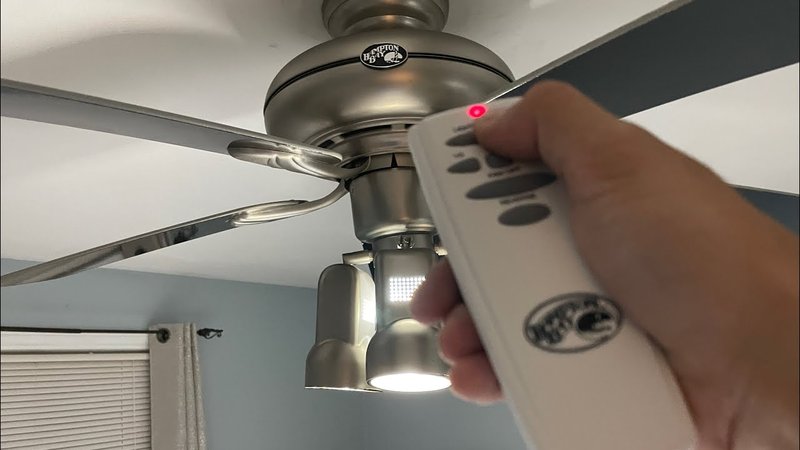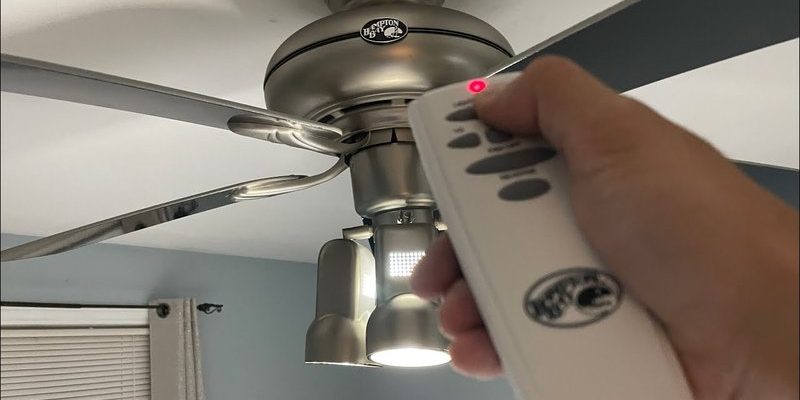
Hampton Bay ceiling fans usually come with their own remotes, designed to make life easier. But after a power outage, those remotes can sometimes lose their connection to the fan. The good news? Getting them “talking” again is much less complicated than it sounds. Even if you feel like you have two left thumbs around electronics, the process is very doable—like following a recipe, just with fewer ingredients and no risk of burning dinner.
Most Hampton Bay fan remotes work using a simple code system (not unlike a garage door opener). When the power blips out, the fan might forget the code or just need a little reset to sync everything up. Knowing how these remotes work, why pairing matters, and the exact steps to re-pair them saves frustration—and keeps your living room breezy and bright.
Common Reasons Hampton Bay Ceiling Fan Remote Stops Working After Outage
First off, why does this even happen? Power outages don’t just turn things off and on—they can scramble the internal “memory” of certain electronics. For Hampton Bay fans, both the ceiling unit and the remote have to agree on a code to communicate. If the electricity flickers or goes out, that connection might be disrupted.
You might notice your remote only works for the light, or nothing at all responds. Sometimes the fan seems to have a mind of its own, cycling through speeds or ignoring commands altogether. This isn’t just random bad luck. Electricity surges or sudden loss of power can reset the pairing between your fan and remote, making them act like strangers afterward.
Here’s the thing: That tiny remote in your hand isn’t “broken”—it just needs to be reintroduced to the fan. This can happen with original Hampton Bay remotes, universal versions, or even those with extra features like dimming. Most of the time, it’s a simple sync issue. Understanding this saves time fiddling with batteries or, worse, buying a new remote when you don’t need one.
How Hampton Bay Ceiling Fan Remotes and Receivers Communicate
Let me explain how your remote and fan actually “talk.” The ceiling fan has a built-in receiver hidden in the canopy (that’s the metal part attached to your ceiling). The remote sends out a radio frequency (RF) signal with a special code every time you press a button. As long as both the remote and receiver are on the same code, every button press gets translated into action.
This code isn’t some super-complex software code—it’s usually a set of small switches known as DIP switches or a digital pairing system. Older Hampton Bay remotes almost always use DIP switches (little toggles hidden under a battery cover). Newer models often have a “learn” button for digital pairing, which is much easier since it only takes a few button presses.
But after a power outage, these codes can be lost or unsynced—like two walkie-talkies set to different channels. That’s why nothing seems to respond or the wrong signal is being picked up. Understanding this simple communication method clears up a lot of the mystery and helps you know exactly what needs fixing.
Step-By-Step Instructions: How to Pair Hampton Bay Ceiling Fan Remote After Power Outage
So you’re standing there, remote in hand, wondering what to do next. Don’t worry—here’s a clear, no-nonsense walk-through. Just take it slow, and your fan will be back online in a few minutes.
- Find the Type of Remote: Check your remote for a small “learn” button (often inside the battery compartment). If you see it, you have a digital pairing remote. No button? Look for a set of tiny DIP switches beside the batteries.
- Turn Off Power: For safety, switch off the circuit breaker or wall switch that controls the fan. Wait a few seconds. This resets the fan receiver, almost like rebooting your router.
- Set DIP Switches (if needed): If your remote and fan use DIP switches, open the battery cover on your remote and the canopy on the ceiling fan. Match the switch positions exactly for both. Use a small screwdriver or pen to flip the switches—match every 1 or 0 carefully.
- Digital Pairing: With the power still off, put fresh batteries in the remote. Restore power. Within 30 seconds, press and hold the “learn” button on your remote until the fan lights blink or the fan starts moving. That means the code synced and pairing is complete.
- Test Everything: Try the fan and light buttons one by one. Everything should work as before. If not, double-check the switch settings or repeat the pairing process slowly.
If you’re feeling nervous, remember: it’s normal to need a couple of tries. The most common mistake is mismatching the DIP switches, or not holding the “learn” button long enough. Patience pays off!
Troubleshooting: What To Do If Hampton Bay Remote Still Won’t Pair
Okay, let’s say things still aren’t working. No shame—it happens. Here are the most common hiccups and how to fix them:
Sometimes, the problem is as simple as weak or dead batteries in the remote. Even if the light flashes when you press a button, low batteries can weaken the signal. Swap in fresh ones, just to be sure. Also, check that the batteries are seated correctly—sometimes a loose contact stops everything.
If you’ve double-checked the code, matched all the DIP switches, and the remote still won’t sync, the issue might be with the receiver inside the fan’s canopy. Power surges can damage this part. In these cases, listen for any clicking or humming from the fan. If you hear nothing when you try to pair, the receiver might need replacing (it happens more often than you’d think after bad storms).
You might be wondering if interference from other electronics or nearby remotes is causing problems. It’s possible, especially in apartment buildings or homes with lots of ceiling fans. If two fans are accidentally set to the same DIP switch code, they’ll both respond to one remote—so always set a unique code to avoid confusion.
Resetting vs. Replacing Hampton Bay Fan Remotes
Here’s a decision you might face: Is it time to reset, or do I need a new remote? Resetting (pairing) is the first step, of course—but if your remote took a hit during the outage, there’s a slim chance it’s actually busted.
Try pairing with a fresh set of batteries and follow the exact steps above. If you get no response at all—no blinking lights, no beep, nothing—the remote could be dead. Before tossing it, try a universal Hampton Bay remote. These are designed to work with most receivers from the same brand, as long as you match the DIP switches or use the “learn” button.
Honestly, most problems after a power outage come down to lost codes or battery issues. A complete replacement is usually the last resort, unless you see visible damage like melted plastic or water inside the remote.
Best Practices to Prevent Remote Pairing Issues in the Future
You might be asking, “Is there anything I can do so I don’t have to do this every time the power flickers?” Good question. A little prevention goes a long way.
- Surge Protectors: Use a whole-house surge protector or install one at your breaker box. This helps shield sensitive electronics (like the ceiling fan receiver) from sudden voltage spikes.
- Regularly Check Batteries: Swap out the batteries every 6–12 months, even if they’re not dead. Weak batteries are the top reason for remote connection issues, and fresh ones keep your signal strong.
- Keep Codes Recorded: Write down your current DIP switch settings and tape it inside the battery cover. If you ever need to re-pair, you’ll have your “secret code” on hand, saving a ton of time.
- Limit Other Wireless Devices: Too many RF devices in one room can cause interference. Try to keep the fan remote on its own frequency (unique DIP switch code).
These steps help make sure the next time a storm rolls through, you’re ready. You’ll never have to fumble through tiny switches or chase down lost codes in the middle of a muggy night.
Comparing Hampton Bay Remotes: Original vs. Universal Options
Not all remotes are created equal, and you might wonder if trying out a universal remote is worth it. If you lost your original Hampton Bay remote, or it’s simply not responding after all your best efforts, universal remotes can be a solid backup plan.
Universal remotes typically offer the same basic features—fan speed control, light dimming, and even reverse functions for certain models. The pairing process is almost identical: match DIP switches or press the “learn” button. However, original remotes made for your specific fan model may offer better signal strength and reliability.
Here’s the thing: Sometimes, older Hampton Bay fans only work with certain frequency codes. Universal remotes claim broad compatibility, but always double-check with your fan’s model number before buying. If your home has multiple Hampton Bay ceiling fans, you might prefer universal remotes with programmable codes to avoid cross-communication.
Original remotes are often easier to find online, especially if you know your fan’s model and can order directly from a major retailer. Universal options offer flexibility but may require some trial and error during the pairing process.
When To Call An Electrician For Hampton Bay Remote Problems
Now, let’s be real—not everyone is comfortable climbing a ladder and poking around inside a ceiling fan. There’s no shame in calling in a pro if you feel uneasy or if repeated pairing attempts fail.
You should reach out to an electrician if you’ve:
- Tried multiple remotes and fresh batteries, but nothing works
- Hear buzzing, humming, or see sparks from the fan canopy
- Notice that the fan or light flickers oddly even when the remote is unresponsive
- Have no experience with electrical wiring and feel unsafe
Sometimes, the receiver inside the fan is fried (not your fault!). An experienced electrician can swap out the receiver, confirm wiring is safe, and even recommend surge protection improvements. The cost is modest compared to replacing the entire fan or risking a DIY mistake.
If in doubt, safety first. It’s better to have an expert handle any wiring or component replacement, especially after a severe outage or power surge.
Final Thoughts On Pairing Your Hampton Bay Ceiling Fan Remote After a Power Outage
Losing your ceiling fan remote connection after a blackout can feel like the last straw on a stressful day. But with a little patience and the right steps, you can bring your Hampton Bay fan back to life before you know it. Most pairing issues boil down to lost codes, low batteries, or—on rare occasions—a faulty receiver. Taking the time to match codes or press the “learn” button can feel like entering a secret club, but once you’ve done it, it’s surprisingly simple.
Honestly, knowing these tricks keeps you in control of your comfort. Plus, it saves time, money, and that awkward moment of guessing which cord to pull or switch to flip. As you get more confident, resetting or pairing will feel as easy as making your morning coffee—something you can do almost on autopilot. And if you ever run into stubborn problems, there are always universal options or professionals who can help. Stay cool, stay curious, and your living room will stay breezy, no matter what the weather outside throws your way.
